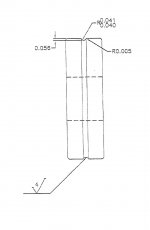Hi Guys, Beginner here. I have to cut this .040-.041"Radius Groove in a part, .056" deep into the part. What Size Full Nose Radius Insert do I need to accomplish this? I assume I use a standard .047" Full Nose Radius insert and by going only .056" deep, should leave me with the .040-.041" Radius but I'm not sure. There must be a formula for this. Any suggestions? This will be done on a manual lathe.




 .
. .
.